Guyana
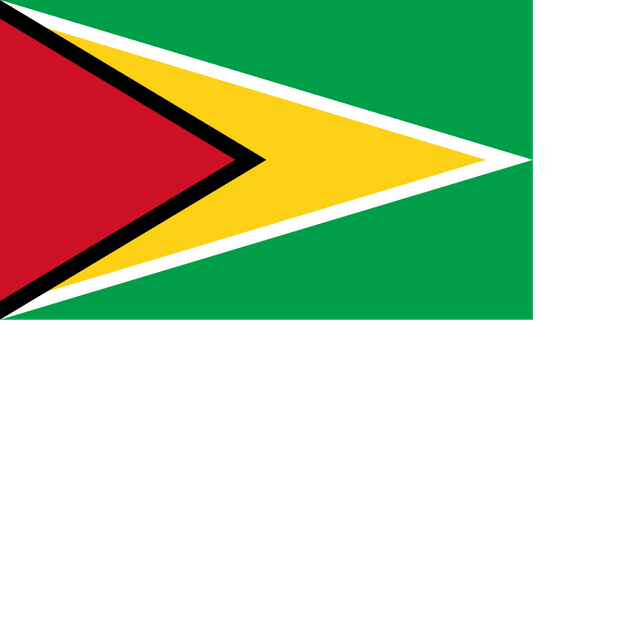
Guyana

Co-operative Republic of Guyana | |
|---|---|
Motto:"One People, One Nation, One Destiny" | |
Anthem:"Dear Land of Guyana, of Rivers and Plains" | |
 Location of Guyana (dark green)in South America (grey) | |
 | |
| Capital and largest city | Georgetown 6°46′N 58°10′W [87] |
| Official languages | English |
| Recognised regional languages | 10 languages
|
| Vernacular language | Guyanese Creole |
| Other languages | 5 languages
|
| Ethnic groups (2012) | |
| Religion |
|
| Demonym(s) | Guyanese |
| Government | Unitary presidential constitutional socialist republic[3] |
• President | David Granger |
• Prime Minister | Moses Nagamootoo |
| Legislature | National Assembly |
| Formation | |
• Dutch Guiana | 1667–1814 |
• British Guiana | 1814–1966 |
• Independence from the United Kingdom becoming Guyana | 26 May 1966 |
• Republic | 23 February 1970 |
• Current constitution | 6 October 1980 |
| Area | |
• Total | 214,970 km2(83,000 sq mi) (83rd) |
• Water (%) | 8.4 |
| Population | |
• 2016 estimate | 783,769[4] (165th) |
• 2012 census | 747,884[5] |
• Density | 3.502/km2(9.1/sq mi) (232nd) |
| GDP(PPP) | 2018 estimate |
• Total | $6.668 billion[6] (163rd) |
• Per capita | $8,524[6] (117th) |
| GDP(nominal) | 2019 estimate |
• Total | $3.830 billion[6] (160th) |
• Per capita | $4,880[6] (100th) |
| HDI(2017) | medium · 125th |
| Currency | Guyanese dollar (GYD) |
| Time zone | UTC-4(Atlantic Standard Time) |
| Driving side | left |
| Calling code | +592 |
| ISO 3166 code | GY |
| Internet TLD | .gy |
Guyana (/ɡaɪˈɑːnə/ or /ɡaɪˈænə/),[8][9] officially the Co-operative Republic of Guyana,[10] is a country on the northern mainland of South America. It is the only English speaking country in South America, and is culturally considered part of the Anglophone-Caribbean sphere. In addition it is one of the founding member countries of the Caribbean Community organization, (CARICOM). Guyana is bordered by the Atlantic Ocean to the north, Brazil to the south and southwest, Venezuela to the west, and Suriname to the east. With an area of 215,000 square kilometres (83,000 sq mi), Guyana is the third-smallest sovereign state on mainland South America after Uruguay and Suriname.
The region known as "the Guianas" consists of the large shield landmass north of the Amazon River and east of the Orinoco River known as the "land of many waters". Major rivers in Guyana include the Essequibo, the Berbice, and the Demerara. Originally inhabited by many indigenous groups, Guyana was settled by the Dutch before coming under British control in the late 18th century. It was governed as British Guiana, with a mostly plantation-style economy until the 1950s. It gained independence in 1966, and officially became a republic within the Commonwealth of Nations in 1970. The legacy of British rule is reflected in the country's political administration and diverse population, which includes Indian, African, Amerindian, and multiracial groups.
Guyana is the only South American nation in which English is the official language. The majority of the population, however, speak Guyanese Creole, an English-based creole language, as a first language. Guyana is considered part of the Anglophone Caribbean. CARICOM, of which Guyana is a member, is headquartered in Guyana's capital and largest city, Georgetown. In 2008, the country joined the Union of South American Nations as a founding member.
Co-operative Republic of Guyana | |
|---|---|
Motto:"One People, One Nation, One Destiny" | |
Anthem:"Dear Land of Guyana, of Rivers and Plains" | |
 Location of Guyana (dark green)in South America (grey) | |
 | |
| Capital and largest city | Georgetown 6°46′N 58°10′W [87] |
| Official languages | English |
| Recognised regional languages | 10 languages
|
| Vernacular language | Guyanese Creole |
| Other languages | 5 languages
|
| Ethnic groups (2012) | |
| Religion |
|
| Demonym(s) | Guyanese |
| Government | Unitary presidential constitutional socialist republic[3] |
• President | David Granger |
• Prime Minister | Moses Nagamootoo |
| Legislature | National Assembly |
| Formation | |
• Dutch Guiana | 1667–1814 |
• British Guiana | 1814–1966 |
• Independence from the United Kingdom becoming Guyana | 26 May 1966 |
• Republic | 23 February 1970 |
• Current constitution | 6 October 1980 |
| Area | |
• Total | 214,970 km2(83,000 sq mi) (83rd) |
• Water (%) | 8.4 |
| Population | |
• 2016 estimate | 783,769[4] (165th) |
• 2012 census | 747,884[5] |
• Density | 3.502/km2(9.1/sq mi) (232nd) |
| GDP(PPP) | 2018 estimate |
• Total | $6.668 billion[6] (163rd) |
• Per capita | $8,524[6] (117th) |
| GDP(nominal) | 2019 estimate |
• Total | $3.830 billion[6] (160th) |
• Per capita | $4,880[6] (100th) |
| HDI(2017) | medium · 125th |
| Currency | Guyanese dollar (GYD) |
| Time zone | UTC-4(Atlantic Standard Time) |
| Driving side | left |
| Calling code | +592 |
| ISO 3166 code | GY |
| Internet TLD | .gy |
Etymology
The name "Guyana" derives from Guiana, the original name for the region that formerly included Guyana (British Guiana), Suriname (Dutch Guiana), French Guiana, and parts of Colombia, Venezuela and Brazil. According to the Oxford English Dictionary, "Guyana" comes from an indigenous Amerindian language and means "land of many waters".[11]
History
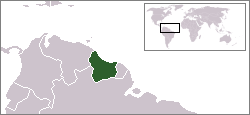
A map of Dutch Guiana 1667–1814
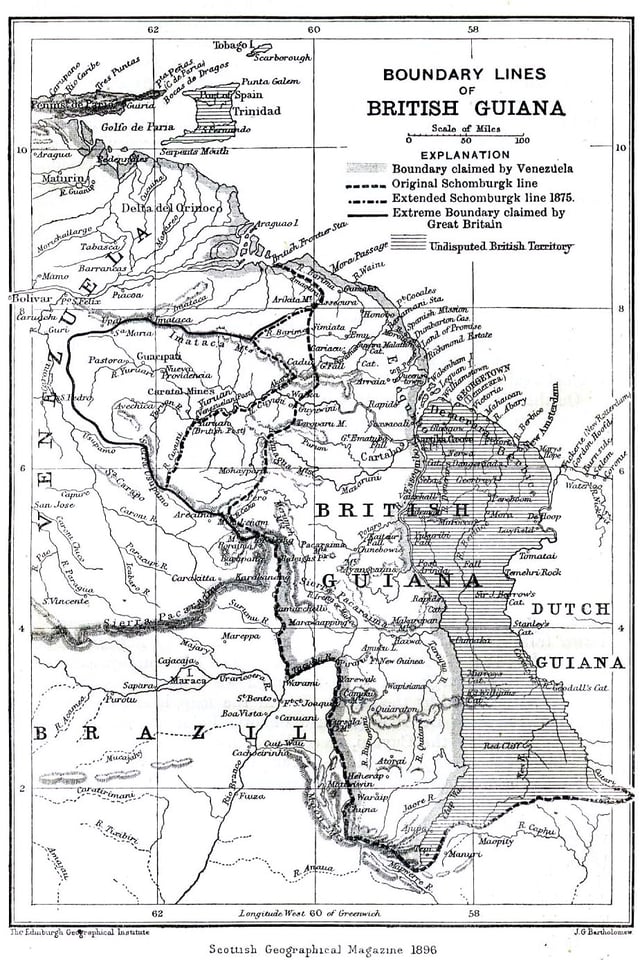
Map of British Guiana from 1896.
There are nine indigenous tribes residing in Guyana: the Wai Wai, Macushi, Patamona, Lokono, Kalina, Wapishana, Pemon, Akawaio and Warao.[12] Historically the Lokono and Kalina tribes dominated Guyana. Although Christopher Columbus was the first European to sight Guyana during his third voyage (in 1498), and Sir Walter Raleigh wrote an account in 1596, the Dutch were the first Europeans to establish colonies: Essequibo (1616), Berbice (1627), and Demerara (1752). After the British assumed control in 1796,[13] the Dutch formally ceded the area in 1814. In 1831 the three separate colonies became a single British colony known as British Guiana.
Since its independence in 1824 Venezuela has claimed the area of land to the west of the Essequibo River. Simón Bolívar wrote to the British government warning against the Berbice and Demerara settlers settling on land which the Venezuelans, as assumed heirs of Spanish claims on the area dating to the sixteenth century, claimed was theirs. In 1899 an international tribunal ruled the land belonged to Great Britain. The British territorial claim stemmed from Dutch involvement and colonization of the area also dating to the sixteenth century, which was ceded to the British.
Guyana achieved independence from the United Kingdom on 26 May 1966 and became a republic on 23 February 1970, remaining a member of the Commonwealth. The US State Department and the US Central Intelligence Agency (CIA), along with the British government, played a strong role in influencing political control in Guyana during this time.[14] The American government supported Forbes Burnham during the early years of independence because Cheddi Jagan was identified as a Marxist. They provided secret financial support and political campaign advice to Burnham's People's National Congress, to the detriment of the Jagan-led People's Progressive Party, which was mostly supported by Guyanese of East Indian background.
In 1978, Guyana received international notice when 918 members of the American cult, Peoples Temple, died in a mass murder/suicide, drinking cyanide-laced Flavor Aid. However, most of the suicides were by Americans and not Guyanese. More than 300 children were killed; the people were members of a group led by Jim Jones in Jonestown, the settlement which they had created. Jim Jones's bodyguards had earlier attacked people taking off at a small remote airstrip close to Jonestown, killing five people, including Leo Ryan, a US congressman.
In May 2008, President Bharrat Jagdeo was a signatory to the UNASUR Constitutive Treaty of the Union of South American Nations. Guyana has ratified the treaty.
Geography
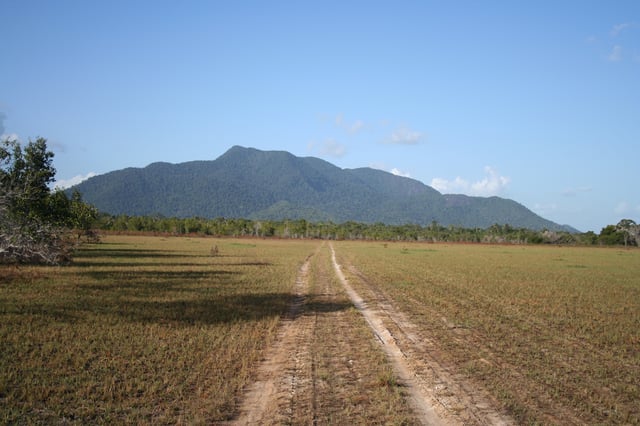
Rupununi Savannah
The territory controlled by Guyana lies between latitudes 1° and 9°N, and longitudes 56° and 62°W.
The country can be divided into five natural regions; a narrow and fertile marshy plain along the Atlantic coast (low coastal plain) where most of the population lives; a white sand belt more inland (hilly sand and clay region), containing most of Guyana's mineral deposits; the dense rain forests (Forested Highland Region) in the southern part of the country; the drier savannah areas in the south-west; and the smallest interior lowlands (interior savannah) consisting mostly of mountains that gradually rise to the Brazilian border.
Some of Guyana's highest mountains are Mount Ayanganna (2,042 metres or 6,699 feet), Monte Caburaí (1,465 metres or 4,806 feet) and Mount Roraima (2,772 metres or 9,094 feet – the highest mountain in Guyana) on the Brazil-Guyana-Venezuela tripoint border, part of the Pakaraima range. Mount Roraima and Guyana's table-top mountains (tepuis) are said to have been the inspiration for Sir Arthur Conan Doyle's 1912 novel The Lost World. There are also many volcanic escarpments and waterfalls, including Kaieteur Falls which is believed to be the largest single-drop waterfall in the world.[15] North of the Rupununi River lies the Rupununi savannah, south of which lie the Kanuku Mountains.
The four longest rivers are the Essequibo at 1,010 kilometres (628 mi) long, the Courentyne River at 724 kilometres (450 mi), the Berbice at 595 kilometres (370 mi), and the Demerara at 346 kilometres (215 mi). The Courentyne river forms the border with Suriname. At the mouth of the Essequibo are several large islands, including the 145 km (90 mi) wide Shell Beach along the northwest coast, which is also a major breeding area for sea turtles (mainly leatherbacks) and other wildlife.
The local climate is tropical and generally hot and humid, though moderated by northeast trade winds along the coast. There are two rainy seasons, the first from May to mid-August, the second from mid-November to mid-January.
Guyana has one of the largest unspoiled rainforests in South America, some parts of which are almost inaccessible by humans. The rich natural history of Guyana was described by early explorers Sir Walter Raleigh and Charles Waterton and later by naturalists Sir David Attenborough and Gerald Durrell. In 2008, the BBC broadcast a three-part programme called Lost Land of the Jaguar which highlighted the huge diversity of wildlife, including undiscovered species and rare species such as the giant otter and harpy eagle.
In 2012, Guyana received a $45 million reward from Norway for its rainforest protection efforts. This stems from a 2009 agreement between the nations for a total of $250 million for protecting and maintaining the natural habitat. Thus far, the country has received $115 million of the total grant.
Regions and Neighbourhood Councils
| No | Region | Area km2 | Pop. (2012 Census) | Pop. Density per km2 |
|---|---|---|---|---|
| 1 | Barima-Waini | 20,339 | 26,941 | 1.32 |
| 2 | Pomeroon-Supenaam | 6,195 | 46,810 | 7.56 |
| 3 | Essequibo Islands-West Demerara | 3,755 | 107,416 | 28.61 |
| 4 | Demerara-Mahaica | 2,232 | 313,429 | 140.43 |
| 5 | Mahaica-Berbice | 4,190 | 49,723 | 11.87 |
| 6 | East Berbice-Corentyne | 36,234 | 109,431 | 3.02 |
| 7 | Cuyuni-Mazaruni | 47,213 | 20,280 | 0.43 |
| 8 | Potaro-Siparuni | 20,051 | 10,190 | 0.51 |
| 9 | Upper Takutu-Upper Essequibo | 57,750 | 24,212 | 0.42 |
| 10 | Upper Demerara-Berbice | 17,040 | 39,452 | 2.32 |
| Total | 214,999 | 747,884 | 3.48 |
The regions are divided into 27 neighbourhood councils.[18]
Boundary disputes
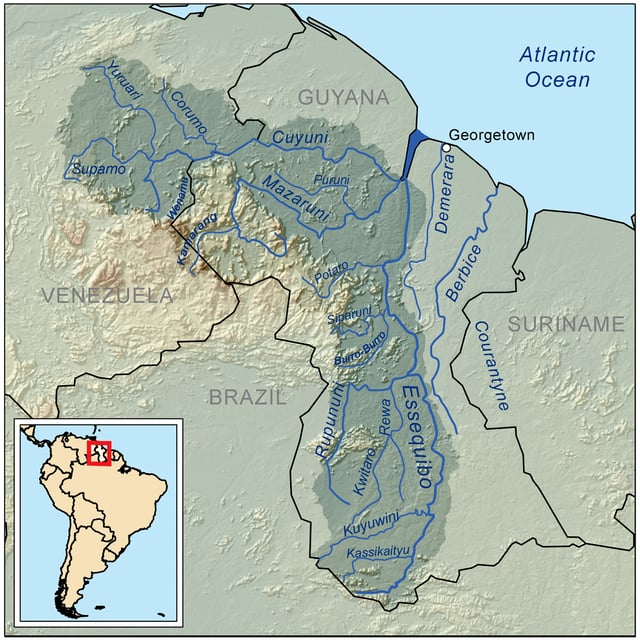
Map of Guyana, showing the Essequibo River and (shaded dark) the river's drainage basin. Venezuela claims territory up to the western bank of the river. The historical claim by the UK included the river basin well into current-day Venezuela.
Guyana is in border disputes with both Suriname, which claims the area east of the left bank of the Corentyne River and the New River in southwestern Suriname, and Venezuela which claims the land west of the Essequibo River, once the Dutch colony of Essequibo as part of Venezuela's Guayana Essequiba.[19][20][21][22] The maritime[23][24] component of the territorial dispute with Suriname was arbitrated by the United Nations Convention on Law of the Sea, and a ruling was announced on 21 September 2007. The ruling concerning the Caribbean Sea north of both nations found both parties violated treaty obligations and declined to order any compensation to either party.[25]
When the British surveyed British Guiana in 1840, they included the entire Cuyuni River basin within the colony. Venezuela did not agree with this as it claimed all lands west of the Essequibo River. In 1898, at Venezuela's request, an international arbitration tribunal was convened, and in 1899 the tribunal issued an award giving about 94% of the disputed territory to British Guiana. The arbitration was concluded, settled and accepted into International law by both Venezuela and the U.K. Venezuela brought up again the settled claim, during the 1960s cold war period, and during Guyana's Independence period. This issue is now governed by the Treaty of Geneva of 1966, which was signed by the Governments of Guyana, Great Britain and Venezuela, and Venezuela continues to claim Guayana Esequiba.[26] Venezuela calls this region "Zona en Reclamación" (Reclamation Zone) and Venezuelan maps of the national territory routinely include it, drawing it in with dashed lines.[27]
Specific small disputed areas involving Guyana are Ankoko Island with Venezuela; Corentyne River[28] with Suriname; and Tigri Area or New River Triangle[29] with Suriname. In 1967 a Surinamese survey team was found in the New River Triangle and was forcibly removed. In August 1969 a patrol of the Guyana Defence Force found a survey camp and a partially completed airstrip inside the triangle, and documented evidence of the Surinamese intention to occupy the entire disputed area. After an exchange of gunfire, the Surinamese were driven from the triangle.
Environment and biodiversity
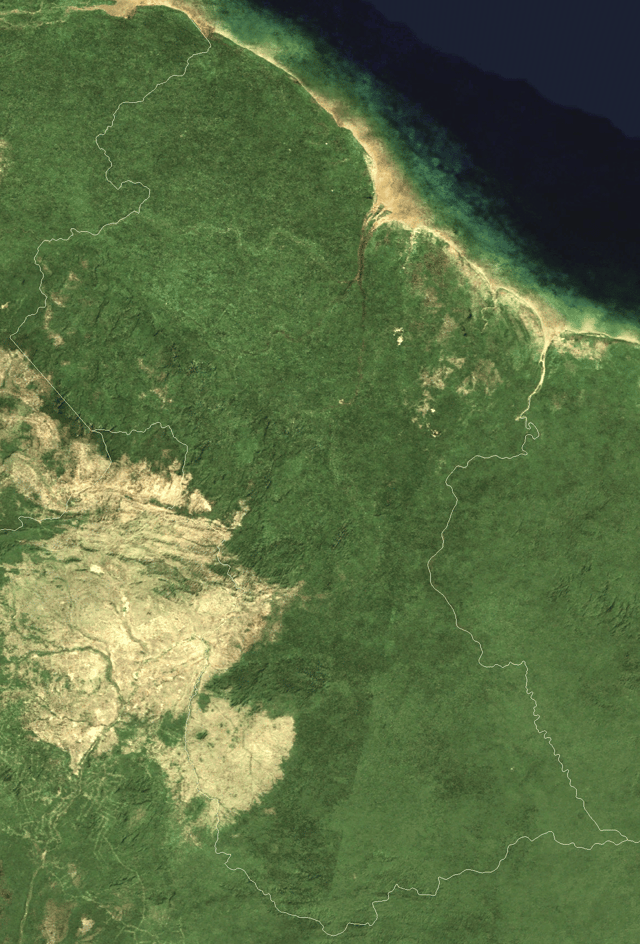
Satellite image of Guyana from 2004
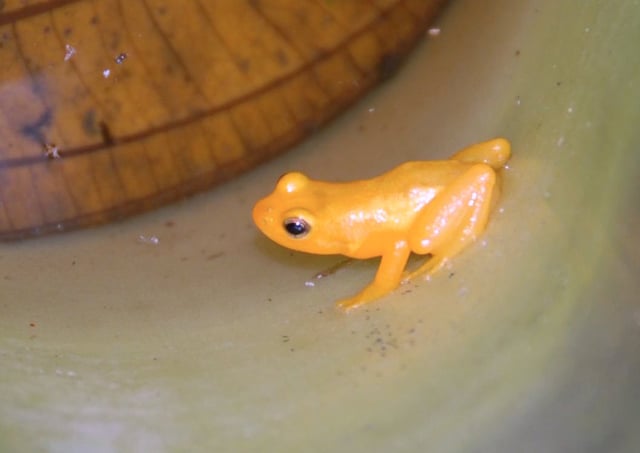
Anomaloglossus beebei (Kaieteur), specific to the Guianas

The hoatzin is the national bird of Guyana.
The following habitats have been categorised for Guyana: coastal, marine, littoral, estuarine palustrine, mangrove, riverine, lacustrine, swamp, savanna, white sand forest, brown sand forest, montane, cloud forest, moist lowland and dry evergreen scrub forests (NBAP, 1999). About 14 areas of biological interest have been identified as possible hotspots for a National Protected Area System. More than 80% of Guyana is still covered by forests, those forest also contains the world's rarest orchids ranging from dry evergreen and seasonal forests to montane and lowland evergreen rain forests. These forests are home to more than a thousand species of trees. Guyana's tropical climate, unique geology, and relatively pristine ecosystems support extensive areas of species-rich rain forests and natural habitats with high levels of endemism. Approximately eight thousand species of plants occur in Guyana, half of which are found nowhere else.
Guyana has one of the highest levels of biodiversity in the world. With 1,168 vertebrate species and 814 bird species, it boasts one of the richest mammalian fauna assemblages of any comparably sized area in the world. The Guiana Shield region is little known and extremely rich biologically. Unlike other areas of South America, over 70% of the natural habitat remains pristine.
The rich natural history of British Guiana was described by early explorers Sir Walter Raleigh and Charles Waterton and later by naturalists Sir David Attenborough and Gerald Durrell.
In February 2004, the Government of Guyana issued a title to more than 1 million acres (4,000 km2) of land in the Konashen Indigenous District declaring this land as the Konashen Community-Owned Conservation Area (COCA), to be managed by the Wai Wai. In doing so Guyana created the world's largest Community-Owned Conservation Area.[30]
This important event followed a request made by the Wai Wai community to the government of Guyana and Conservation International Guyana (CIG) for assistance in developing a sustainable plan for their lands in Konashen. The three parties signed a Memorandum of Cooperation which outlines a plan for sustainable use of the Konashen COCA's biological resources, identifies threats to the area's biodiversity, and helps develop projects to increase awareness of the COCA as well as generate the income necessary to maintain its protected status.
The Konashen Indigenous District of Southern Guyana houses the headwaters of the Essequibo River, Guyana's principal water source, and drains the Kassikaityu, Kamoa, Sipu and Chodikar rivers. Southern Guyana is host to some of the most pristine expanses of evergreen forests in the northern part of South America. Most of the forests found here are tall, evergreen hill-land and lower montane forests, with large expanses of flooded forest along major rivers. Thanks to the very low human population density of the area, most of these forests are still intact. The Smithsonian Institution has identified nearly 2,700 species of plants from this region, representing 239 distinct families, and there are certainly additional species still to be recorded.
The diversity of plants supports diverse animal life, recently documented by a biological survey organised by Conservation International. The reportedly clean, unpolluted waters of the Essequibo watershed support a remarkable diversity of fish and aquatic invertebrates, and are home to giant otters, capybaras, and several species of caimans.
On land, large mammals, such as jaguars, tapirs, bush dogs, giant anteaters, and saki monkeys are still common. Over 400 species of birds have been reported from the region, and the reptile and amphibian faunas are similarly rich. The Konashen COCA forests are also home to countless species of insects, arachnids, and other invertebrates, many of which are still undiscovered or unnamed.
The Konashen COCA contains a high level of biological diversity and richness that remains in nearly pristine condition; such places have become rare on earth. This fact has given rise to various non-exploitative, environmentally sustainable industries such as ecotourism, successfully capitalising on the biological wealth of the Konashen COCA with comparatively little enduring impact.
World Heritage sites
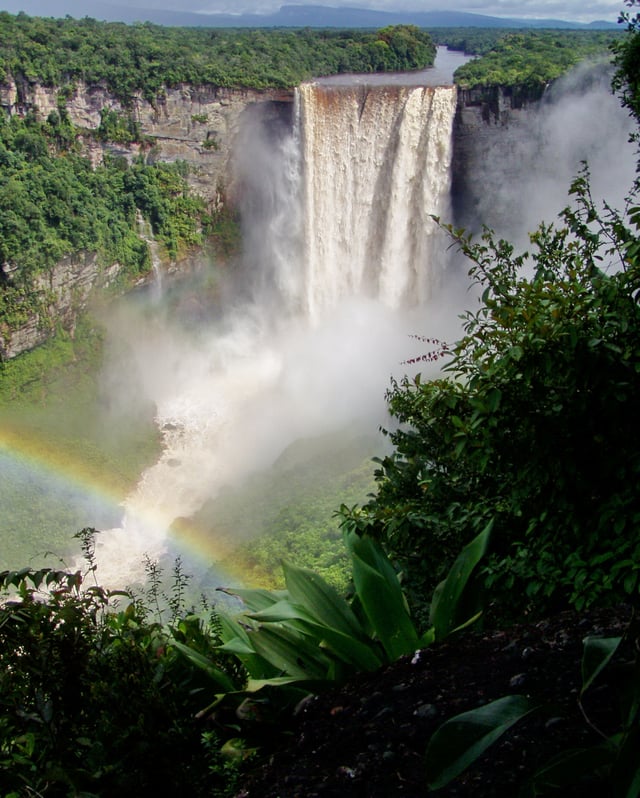
Kaieteur Falls is the world's largest single-drop waterfall by volume.
Guyana signed the Convention Concerning the Protection of the World Cultural and Natural Heritage treaty in 1977, the first South American country to do so. In the mid-1990s, Guyana began the process of selecting sites for World Heritage nomination, and three sites were considered: Kaieteur National Park, Shell Beach and Historic Georgetown. By 1997, work on Kaieteur National Park was started, and in 1998 work on Historic Georgetown was begun. To date, however, Guyana has not made a successful nomination.
Guyana submitted the Kaieteur National Park, including the Kaieteur Falls, to UNESCO as its first World Heritage Site nomination. The proposed area and surrounds have some of Guyana's most diversified life zones with one of the highest levels of endemic species found in South America. The Kaieteur Falls are the most spectacular feature of the park, falling a distance of 226 metres. The nomination of Kaieteur National Park as a World Heritage Site was not successful, primarily because the area was seen by the evaluators as being too small, especially when compared with the Central Suriname Nature Reserve that had just been nominated as a World Heritage Site (2000). The dossier was thus returned to Guyana for revision.
Guyana continues in its bid for a World Heritage Site. Work continues, after a period of hiatus, on the nomination dossier for Historic Georgetown. A tentative list indicating an intention to nominate Historic Georgetown was submitted to UNESCO in December 2004. In April 2005, two Dutch experts in conservation spent two weeks in Georgetown supervising architecture staff and students of the University of Guyana in a historic building survey of the selected area. This is part of the data collection for the nomination dossier.
Meanwhile, as a result of the Kaieteur National Park being considered too small, there is a proposal to prepare a nomination for a Cluster Site that will include the Kaieteur National Park, the Iwokrama Forest and the Kanuku Mountains. The Iwokrama rain forest, an area rich in biological diversity, has been described by Major General (Retired) Joseph Singh as "a flagship project for conservation." The Kanuku Mountains area is in a pristine state and is home to more than four hundred species of birds and other animals.
Guyana holds two of the World Wildlife Fund's Global 200 eco-regions, the Guianan and Guiana Highlands moist forests. It is also home to several endemic species including the greenheart tree.
Landmarks
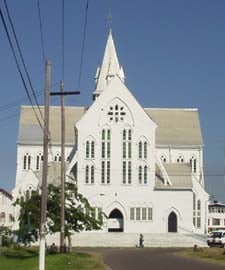
St George's Cathedral, Georgetown
- St George's Anglican CathedralA historic Anglican Cathedral made of wood.Demerara Harbour BridgeThe world's fourth-longest floating bridge.Berbice BridgeThe world's sixth-longest floating bridge.Caribbean Community (CARICOM) BuildingHouses the headquarters of the largest and most powerful economic union in the Caribbean.Providence StadiumSituated on Providence on the north bank of the Demerara River and built in time for the ICC World Cup 2007, it is the largest sports stadium in the country. It is also near the Providence Mall, forming a major spot for leisure in Guyana.Guyana International Conference CentrePresented as a gift from the People's Republic of China to the Government of Guyana. It is the only one of its kind in the country.Stabroek MarketA large cast-iron colonial structure that looked like a statue was located next to the Demerara River.City HallA beautiful wooden structure also from the colonial era.Takutu River BridgeA bridge across the Takutu River, connecting Lethem in Guyana to Bonfim in Brazil.Takutu River Bridge [88]Umana YanaAn Amerindian benab, that is a national monument built in 1972, for a meeting of the Foreign Ministers of the Non-Aligned nations (It was rebuilt in 2016).
Economy
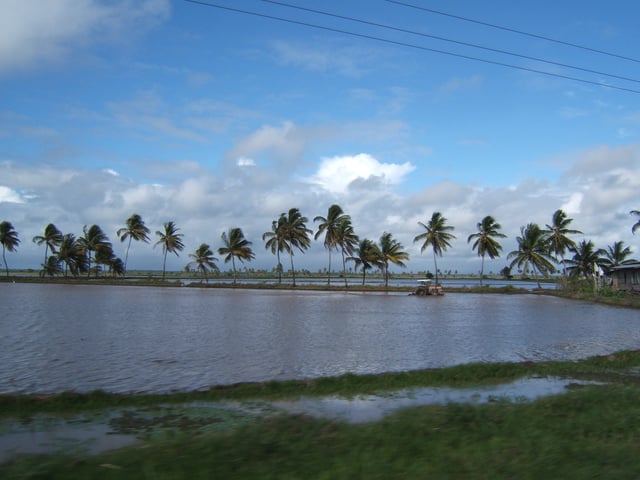
A tractor in a rice field on Guyana's coastal plain
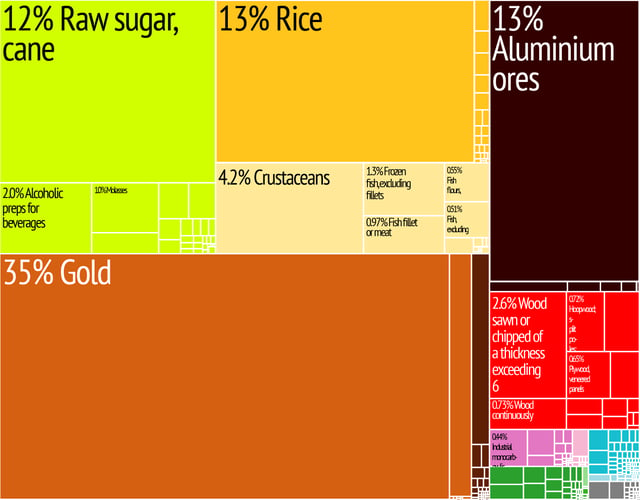
Graphical depiction of Guyana's product exports in 28 colour-coded categories
The main economic activities in Guyana are agriculture (production of rice and Demerara sugar), bauxite and gold mining, timber, shrimp fishing and minerals. The sugar industry, which accounts for 28% of all export earnings, is largely run by the company GuySuCo, which employs more people than any other industry. Many industries have a large foreign investment. For example, the American company Reynolds Metals and the British-Australian Rio Tinto's Rio Tinto Alcan subsidiary are heavily invested in Guyana's mineral industry; the Korean/Malaysian Barama Company has a large stake in the logging industry. Since 2015, foreign companies have made several significant deep water oil discoveries.
Chronic problems include a shortage of skilled labour, deficient infrastructure, and until recently, sizable external debt. Low prices for key mining and agricultural commodities, combined with troubles in the bauxite and sugar industries, had threatened the government's tenuous fiscal position and dimmed prospects for the future. However, the Guyanese economy has rebounded slightly and exhibited moderate economic growth since 1999, thanks to an expansion in the agricultural and mining sectors, a more favourable atmosphere for business initiatives, a more realistic exchange rate, fairly low inflation, and the continued support of international organisations. In 2008, the economy witnessed a 3% increase in growth amid the global economic crisis. It grew 5.4% in 2011 and 3.7% in 2012.
The production of balatá (natural latex) was once big business in Guyana. Most of the balata bleeding in Guyana took place in the foothills of the Kanuku Mountains in the Rupununi. Early exploitation also took place in the North West District, but most of the trees in the area were destroyed by illicit bleeding methods that involved cutting down the trees rather than making incisions in them. Uses of balatá included the making of cricket balls, the temporary filling of troublesome tooth cavities, and the crafting of figurines and other decorative items (particularly by the Macushi people of the Kanuku mountains).
The government initiated a major overhaul of the tax code in early 2007. A Value Added Tax (VAT) replaced six different taxes. Prior to the implementation of the VAT, it had been relatively easy to evade sales tax, and many businesses were in violation of tax code. Many businesses opposed VAT introduction because of the extra paperwork required; however, the Government has remained firm on the VAT. By replacing several taxes with one flat tax rate, it will also be easier for government auditors to spot embezzlement. This was prevalent under the former PPP/C government who authorised the VAT to be equal to 50% of the value of the good.
President Bharrat Jagdeo had made debt relief a priority. He convinced the International Monetary Fund (IMF), the World Bank and the Inter-American Development Bank (IDB) to write off US$800 million of debt, and millions more owed to industrial nations. Jagdeo was lauded by IDB President Moreno for his strong leadership and negotiating skills.
Summary
International and regional relations
The Organisation of American States (OAS)
Guyana entered the Inter–American system in 1991.[34]
Indigenous Leaders Summits of America (ILSA)
With Guyana having many groups of indigenous persons and given the geographical location of the country, the contributions of the Guyanese to the OAS respecting indigenous people may be significant.[35]
The position of the OAS respecting indigenous persons developed over the years. "The "OAS has supported and participated in the organisation of Indigenous Leaders Summits of Americas (ILSA)"[36]
The Draft American Declaration of the Rights of the Indigenous Persons appears to be a working document[37]
Agreements which affect financial relationships
The Double Taxation Relief (CARICOM) Treaty 1994
At a CARICOM Meeting, representatives of Trinidad and Tobago and Guyana respectively signed The Double Taxation Relief (CARICOM) Treaty 1994 on 19 August 1994.[38]
This treaty covered taxes, residence, tax jurisdictions, capital gains, business profits, interest, dividends, royalties and other areas.
FATCA
On 30 June 2014, Guyana signed a Model 1 agreement with the United States of America in relation to the Foreign Account Tax Compliance Act (FATCA).[39] This Model 1 agreement includes a reference to the Tax Information Exchange Agreement (Clause 3) which was signed on 22 July 1992 in Georgetown, Guyana intending to exchange Tax information on an automatic basis.
Demographics
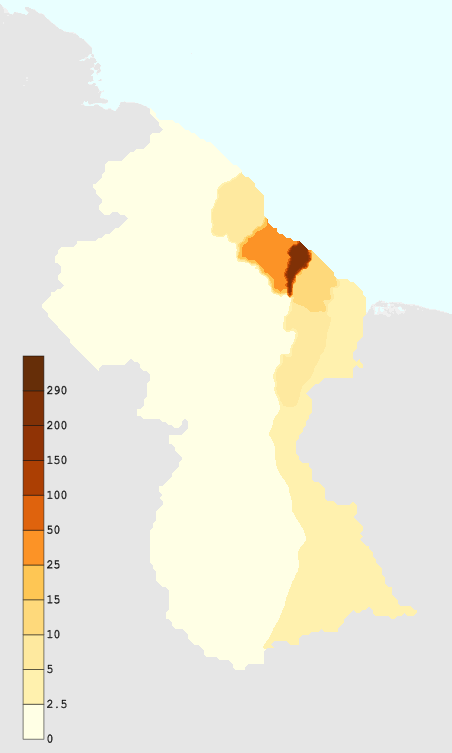
Guyana's population density in 2005 (people per km2)
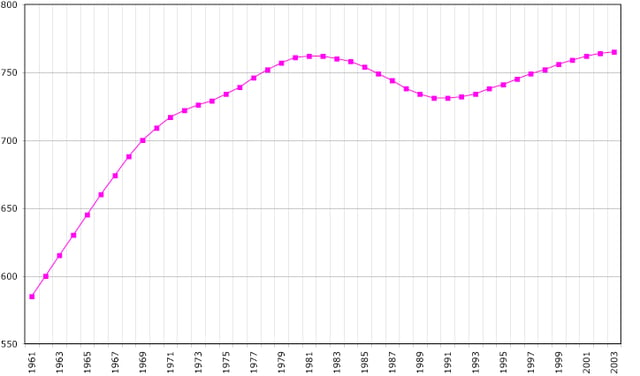
A graph showing the population of Guyana from 1961 to 2003. The population decline in the 1980s can be clearly seen.
The chief majority (about 90%) of Guyana's 773,000 population lives along a narrow coastal strip which ranges from a width of 16 to 64 kilometres (10 to 40 mi) inland and which makes up approximately only 10% of the nation's total land area.[40]
The largest ethnic group is the Indo-Guyanese (also known as East Indians), the descendants of indentured laborers from India, who make up 43.5% of the population, according to the 2002 census. They are followed by the Afro-Guyanese, the descendants of slaves from Africa, who constitute 30.2%. The Guyanese of mixed heritage make up 16.7%, while the indigenous peoples (known locally as Amerindians) make up 9.1%. The indigenous groups include the Arawaks, the Wai Wai, the Caribs, the Akawaio, the Arecuna, the Patamona, the Wapixana, the Macushi and the Warao.[33] The two largest groups, the Indo-Guyanese and Afro-Guyanese, have experienced some racial tension.[41][42][43]
The majority of Indo-Guyanese are descended from indentured laborers who came from Bhojpuri-speaking areas of North India.[44] A sizable minority are South Indian, largely of Tamil and Telugu descent.[45]
The distribution pattern in the 2002 census was similar to those of the 1980 and 1991 censuses, but the share of the two main groups has declined. Indo-Guyanese made up 51.9% of the total population in 1980, but by 1991 this had fallen to 48.6%, and then to 43.5% in the 2002 census. Those of African descent increased slightly from 30.8% to 32.3% during the first period (1980 and 1991) before falling to 30.2% in the 2002 census. With small growth in the overall population, the decline in the shares of the two larger groups has resulted in the relative increase of shares of the multiracial and Amerindian groups. The Amerindian population rose by 22,097 people between 1991 and 2002. This represents an increase of 47.3% or annual growth of 3.5%. Similarly, the multiracial population increased by 37,788 persons, representing a 43.0% increase or annual growth rate of 3.2% from the base period of 1991 census.
The number of Portuguese people (4.3% of the population in 1891) has been declining constantly over the decades.[46]
Largest cities
| Rank | Name | Region | Population |
|---|---|---|---|
| 1 | Georgetown | Demerara-Mahaica | 235,017 |
| 2 | Linden | Upper Demerara-Berbice | 44,690 |
| 3 | New Amsterdam | East Berbice-Corentyne | 35,039 |
| 4 | Anna Regina | Pomeroon-Supenaam | 12,448 |
| 5 | Bartica | Cuyuni-Mazaruni | 11,157 |
| 6 | Skeldon | East Berbice-Corentyne | 5,859 |
| 7 | Rosignol | Mahaica-Berbice | 5,782 |
| 8 | Mahaica (village) | Demerara-Mahaica | 4,867 |
| 9 | Parika | Essequibo Islands-West Demerara | 4,081 |
| 10 | Vreed en Hoop | Demerara-Mahaica | 3,073 |
Languages
English is the official language of Guyana and is used for education, government, media, and services. The vast majority of the population speaks Guyanese Creole, an English-based creole with slight African and East Indian influence, as their native tongue.[48] In addition, Cariban languages (Akawaio, Wai-Wai, and Macushi) are spoken by a small minority, while Indic languages are retained for cultural and religious reasons.
Religion
According to a 2002 nationwide census on religious affiliation, 57.4% of the population was Christian, 28.4% was Hindu, 7.2% was Muslim, 1.9% adhered to other religions, while 2.3% of the population did not profess any.[50]
Among Christians, most are Protestants (34.8%) or other Christian (20.8%), but there is also a minority of Roman Catholics (7.1%). Among Hindu, Vaishnavism is the major tradition. Among Muslims, Sunni are in the majority, while there are also Shia and Ahmadiyya minorities. Among other religions, the Rastafari movement, Buddhism, and the Baha'i Faith are the most popular.
Government and politics

The State House, Guyana's presidential residence
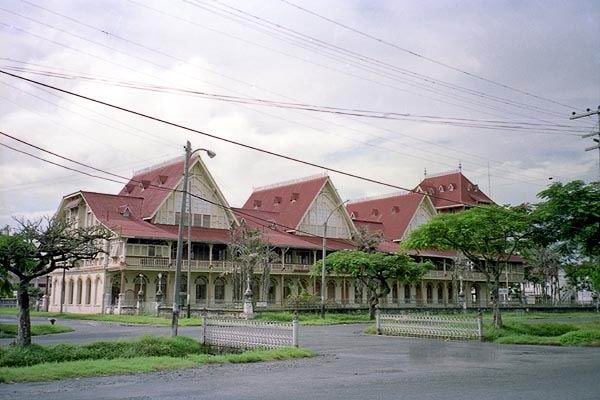
The Supreme Court of Guyana

Guyana's parliament building since 1834
The politics of Guyana takes place in a framework of a presidential representative democratic republic, in which the President of Guyana is both head of state and head of government, and of a multi-party system. Executive power is exercised by the President and the Government. Legislative power is vested in both the President and the National Assembly of Guyana. Historically, politics are a source of tension in the country, and violent riots have often broken out during elections. During the 1970s and 1980s, the political landscape was dominated by the People's National Congress.
In 1992, the first "free and fair" elections were overseen by former United States President Jimmy Carter, and the People's Progressive Party led the country until 2015. The two parties are principally organised along ethnic lines and as a result often clash on issues related to the allocation of resources. In the General Elections held on 28 November 2011, the People's Progressive Party (PPP) retained a majority, and their presidential candidate Donald Ramotar was elected as President.
On 11 May 2015, early general elections were held. A coalition of the A Partnership for National Unity-Alliance for Change (APNU-AFC) parties won 33 of the 65 seats in the National Assembly. On 16 May 2015, retired army general David A. Granger became the eighth President of Guyana. However, on 21 December 2018, a vote of confidence was called for, regarding terms under which the government granted a franchise for offshore oil exploration. Legislator Charrandass Persaud defected from the coalition and the vote failed, requiring new elections. The governing coalition litigated this result for the entire 90 days allowed for new elections.[51]
Public procurement
Public procurement in Guyana is overseen by the Public Procurement Commission, appointed under the Public Procurement Commission Act 2003. Due to lengthy delay in identifying and agreeing commission members, the commission was not appointed until 2016.[52]
Military
The Guyana Defence Force (GDF) is the military service of Guyana.
Human rights
Homosexual acts are illegal in Guyana.[53]
Infrastructure and telecommunications
Transport
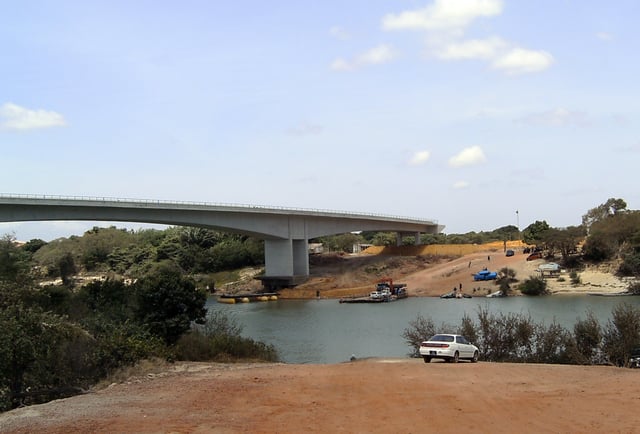
Cross-border bridge from Guyana to Brazil near Lethem
There are a total of 187 kilometres (116 mi) of railway, all dedicated to ore transport. There are 7,969 kilometres (4,952 mi) of highway, of which 591 kilometres (367 mi) are paved. Navigable waterways extend 1,077 kilometres (669 mi), including the Berbice, Demerara, and Essequibo rivers. There are ports at Georgetown, Port Kaituma, and New Amsterdam. There are two international airports (Cheddi Jagan International Airport, Timehri and Eugene F. Correira International Airport (formerly Ogle Airport); along with about 90 airstrips, nine of which have paved runways. Guyana, Suriname and the Falkland Islands are the only three regions in South America which drive on the left.
Electricity
The electricity sector in Guyana is dominated by Guyana Power and Light (GPL), the state-owned vertically integrated utility. Although the country has a large potential for hydroelectric and bagasse-fueled power generation, most of its 226 MW of installed capacity correspond to inefficient diesel-engine driven generators.
Several initiatives are in place to improve energy access in the hinterland.
Health
Life expectancy at birth is estimated to be 67.39 years for both males and females in 2012.[54] The PAHO/ WHO Global Health Report 2014 (using statistics of 2012) ranked the country as having the highest suicide rate in the world, with a mortality rate of 44.2 per 100,000 inhabitants.[55][56] According to 2011 estimates from the WHO, HIV prevalence is 1.2% of the teen/adult population (ages 15–49).[57]
Education
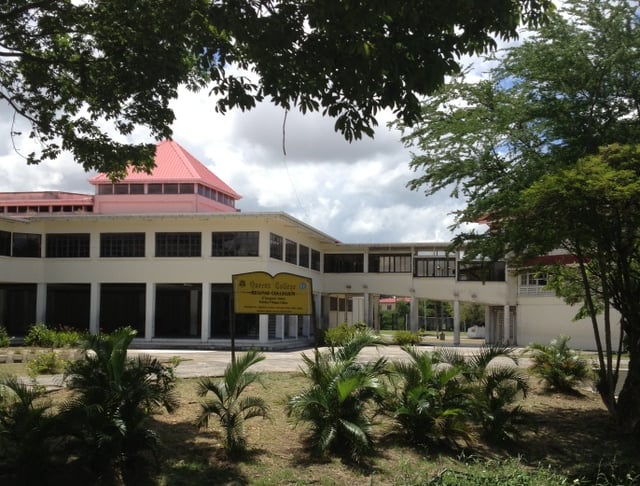
Guyana lacks a critical mass of expertise in many of the disciplines and activities on which it depends. At 88.5%, Guyana's literacy rate is the lowest in South America.[58]
The educational system does not sufficiently focus on the training of Guyanese in science and technology, technical and vocational subjects, business management, or computer sciences. The Guyanese education system is modelled on the former British education system. Students are expected to take the NGSA (National Grade Six Assessment) for entrance into high school in grade 7. They take the CXC at the end of high school. Schools have introduced the CAPE exams which all other Caribbean countries have introduced. The A-level system, inherited from the British era, is offered only in a few schools.
Culture
| 1 January | New Year's Day |
| Spring | Youman Nabi (Mawlid) |
| 23 February | Republic Day / Mashramani |
| March | Phagwah |
| March / April | Good Friday |
| March / April | Easter Sunday |
| 1 May | Labour Day |
| 5 May | Indian Arrival Day |
| 26 May | Independence Day |
| First Monday in July | CARICOM Day |
| 1 August | Emancipation Day |
| October / November | Diwali |
| 25 December | Christmas |
| 26 or 27 December | Boxing Day |
Guyana's culture is very similar to that of the English-speaking Caribbean, and has historically been tied to the English-speaking Caribbean as part of the British Empire when it became a possession in the nineteenth century. Guyana is a founding member of the Caricom (Caribbean Community) economic bloc and also the home of the Bloc's Headquarters, the CARICOM Secretariat.
Guyana's geographical location, its sparsely populated rain-forest regions, and its substantial Amerindian population differentiate it from English-speaking Caribbean countries. Its blend of Indo-Guyanese (East Indian) and Afro-Guyanese (African) cultures gives it similarities to Trinidad and distinguishes it from other parts of the Americas. Guyana shares similar interests with the islands in the West Indies, such as food, festive events, music, sports, etc.
Guyana plays international cricket as a part of the West Indies cricket team, and the Guyana team plays first-class cricket against other nations of the Caribbean. In March and April 2007 Guyana co-hosted the Cricket World Cup 2007. In addition to its CARICOM membership, Guyana is a member of CONCACAF, the international football federation for North and Central America and the Caribbean.
Events include Mashramani (Mash), Phagwah (Holi), and Deepavali (Diwali).
Wildlife
Guyana is home to more than 900 species of birds; 225 species of mammals; 880 species of reptiles and more than 6,500 different species of trees and plants.[59] Among these wildlife categories the most notably famous are the Arapaima, which is the world's largest scaled freshwater fish, Giant Anteater, the World's largest anteater, Giant River Otter, the world's largest and rarest river otter and lastly the most notably famous of birds, cock of the rock (Rupicola rupicola).[60]
Sports
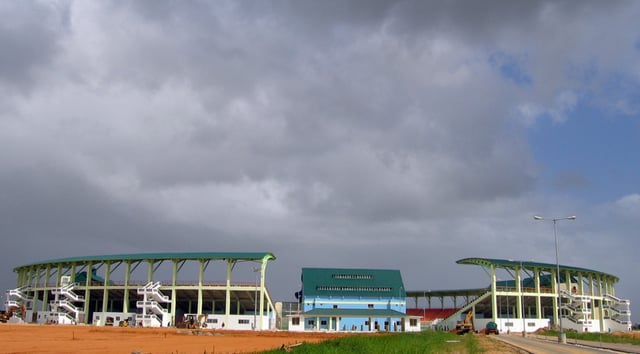
Providence Stadium as seen from the East Bank Highway
The major sports in Guyana are cricket (Guyana is part of the West Indies as defined for international cricket purposes[61]), basketball, football (soccer), and volleyball.[62] Minor sports include softball cricket (beach cricket), field hockey, netball, rounders, lawn tennis, table tennis, boxing, squash, rugby, horse racing and a few others.
Guyana played host to international cricket matches as part of the 2007 Cricket World Cup (CWC 2007). The new 15,000-seat Providence Stadium, also referred to as Guyana National Stadium, was built in time for the World Cup and was ready for the beginning of play on 28 March. At the first international game of CWC 2007 at the stadium, Lasith Malinga of the Sri Lankan team took four wickets in four consecutive deliveries.[63]
For international football purposes, Guyana is part of CONCACAF. The highest league in their club system is the GFF Elite League.
Guyana also has five courses for horse racing.[64]
See also
Index of Guyana-related articles
Outline of Guyana
